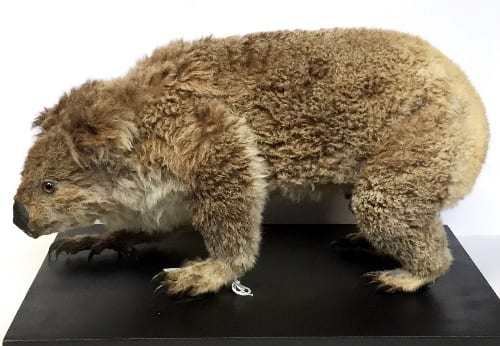Specimen of the Week 330: The taxidermy koala – The language of natural history
By Jack Ashby, on 16 February 2018
With generic terms like mankind and Homo sapiens (“wise man”), people of all genders are well aware that it is the masculine that has dominated the vocabulary of humanity. Not so in the animal kingdom.
Across UCL Culture we are celebrating the centenary of some women first getting the vote in the UK in a number of different ways. In the run up to International Women’s Day, here on the blog our Specimens of the Week will be exploring themes like women in natural history, female specimens, and – in this case – the language of natural history. This week’s Specimen of the Week is…

Koalas are one of many Australian mammals that are named after a characteristic that only females have. Their scientific name Phascolarctos means “pouched bear”. LDUCZ-Z65
***The taxidermy koala***
I find it interesting to think about animals that are named after features that only one sex has. How would you feel if your species was defined by a characteristic that you yourself didn’t possess?* My own passion is the mammals of Australia. Unlike many other groups (for example there are entire groups of insects that can only be identified by studying male genitalia), for those animals which are named for sex-specific features, Australian mammals are almost** universally named after things that only appear in females.
Animals are regularly named for the things that set them apart: the characteristics that make them “different”. Although marsupials are remarkable in a number of ways, what the taxonomists who described the major groups highlighted was the pouch in which the females typically house their developing young.
To begin with, the entire group is named the females’ pouch: marsupium is Latin for “purse”. And across the names of different marsupials we see references to the pouch come up time and again.

A bandicoot being released on ecological fieldwork. Their scientific name means “pouched badger”. (C) Jack Ashby
The words “Phasco-“, “Thyla-“ (or “Thylo-”) and “Pera-“ are all translations of words that mean “pouch”. These appear in names of a wide range of Australian marsupials:
- Koalas’ scientific name is Phascolarctos: pouched bear.
- Bandicoots’ scientific name is Perameles: pouched badger.
- Tasmanian tigers or thylacines are named Thylacinus: pouched dog (though interestingly male thylacines also had pouches, into which they could withdraw their scrotums).
- Phascogales are a group of small carnivorous marsupials – their name means pouched weasel.
- Pademelons’ (small kangaroo-relatives) scientific name is Thylogale, which also means pouched weasel. This is particularly lazy as they do not resemble weasels at all.
- The name echympera (a spiny kind of bandicoot) means pouched hedgehog.
All of these animals’ names refer to the females’ pouch. It’s worth noting that male marsupials also have some pretty remarkable reproductive apparatus which could have been the basis for naming: their penises sit behind the scrotum and in most cases are forked.
The male marsupials’ forked penises match the females’ paired vaginae (they have two – one on the left and one on the right), and these lead onto paired wombs (if you think about the human reproductive system which have right and left ovaries and fallopian tubes, that paired symmetry continues all the way through in marsupials). Indeed, American marsupials – which were described centuries before the Australian ones – are named for this aspect of the female anatomy. The opossums are called Didelphis, meaning two wombs. Australian marsupials originally shared that name until they were deemed different enough to get their own.
So considering the language of natural history, when we choose to base an animal’s name on a feature that only one sex possesses, we are in a sense declaring that this feature defines the entire species. By extension, we might argue that this sex then becomes the more representative of the two.
* To be clear, I’m not suggesting that taxonomic nomenclature is “unfair”. Obviously, koalas have no opinion on the meaning of the words we humans choose to give to them.
** The only exceptions are three species of sheath-tailed bat in the genus Saccolaimus, a name which means “throat pouch” (the pouch in question is more prominent in males); and the eastern long-eared bat, whose scientific name Nyctophilus bifax means “bifurcated night-lover”: it is the bone in the males’ penis which is bifurcated (forked).
Jack Ashby is Manager of the Grant Museum of Zoology.
One Response to “Specimen of the Week 330: The taxidermy koala – The language of natural history”
- 1
 Close
Close



Yes… mammals! “< classical Latin mamma breast, udder"… Though I suppose males have them if only non-functioning! 😉